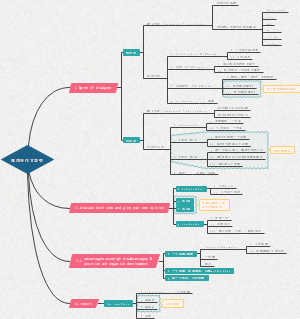导图社区 Android-英语一阅读方法
- 131
- 21
- 4
- 举报
Android-英语一阅读方法
这是一篇关于英语一阅读方法的思维导图,介绍了细节题、例证题、中心思想、推理判断题、词汇题和作者态度等题型的解题方法。
编辑于2021-09-16 16:00:30- 题
- 相似推荐
- 大纲
阅读
阅读方法
考场之上无跳读!
先题后文,只看题干
串联题干间逻辑,推测文章主题
反复提及
是否看选项?
一般不看
选项中有相同关键词看
通读全文
读一段做一题
顺序定位原则
the best title
学会抓作者态度(感情色彩)
adj
adv
系动词后n
句子间逻辑关系,段落间逻辑关系
单词!词组!
相同
相反
but/however
时态
逻辑梳理
“少数派原则”——真理掌握在少数人手中
定位词
大写/人名/地点/时间/年代/数字
名词/形容词
区分观点和举例(举例为说明观点)
抓文章框架时,观点仔细分析,举例迅速略读
标点符号的运用
逗号
两个逗号之间,或一个逗号之后为补充说明部分
两逗号之间先略过
非主干
冒号
冒号后内容解释前面的内容
“=”
分号
分号前后为并列关系
“=”
引号
引用
反语或语义转换
选项里出现引号内内容,但无引号,一般是错的
冠词发生改变也为错
定冠词the和不定冠词a/an之间的变换
句子间的逻辑关系
并列
转折
因果
在翻译的基础上建立句子间的联系是理解文章的关键
互为相反选项中,往往有正确答案
such前文提到
分词做状语:因果关系
套路
少数派原则
时间对比原则
发生在过去和现在的截然相反
标志
now
因果
问什么答什么
because/since/as/for
derive from/originate from/stem from/result from
+原因
owing to/due to/attribute to+原因“把...归因于” contribute/lead to
定语从句表示因果关系(解释说明)
however+adj/adv“无论”
Ved:related/involed/concered等,构成形容词,做后置定语
歧义句用上下文判断其意思
细节题
标志
典型提问
because
what/which/why...
题干细节多
不是其他类型题
干扰选项特征
正反混淆
概念偷换
答非所问
题干中陷阱
不同内容嫁接
拼凑
逻辑错误
and→although
非最佳答案
最佳标志:反复提及
绝对化用词
原文提到做标记
only/must/exclusively/never/all/最高级
通常不选
除非原文明确提到
推理过度
2007-1-23 D断章取义
正确答案特征
同义改写
考察词汇
与中心思想密切相关
反复提及
细节服从主旨
语气缓和
some/may/partly
细节服从主旨
选择与中心主旨最相关的选项
题号
2001
2001-2-26 because
2001-4-35 (C)
2005
2005-1-23 because
2005-2-30 because
2006-2-29 because
2007
2007-1-23 BC曲解
2007-2-26
2007-2-28
2008-4-37
定位好的句子是解题最重要的依据
定位好的句子
答案
例证题
方法
标志
case
cite
demonstrate
example
illustrate
to“为了”
to show
例子本身不重要,重要的是例子支持的观点
定位好的句子(例子)
干扰
观点一般在例子前,有时在例子后
观点和例子可以在不同段落
全文主旨,或段落主旨
重点关注对象
例子前后某个总结说明性句子
论点
干扰选项
就事论事(讲例子内容)
排除
正确选项
符合中心是最佳答案
全面是最佳答案
同义替换
题号
2001
2001-1-23 demonstrate
2001-2-27 case
2003
1
2003-1-22 to
2
2003-2-26 to
2003-2-28 show
4
2003-4-37 example
2004
2004-1-24
2004-2-46 illustrate
2005-4-39 show
2006-4-36 example...show
2008-4-39 冠词改变、引号消失
2009-3-34 to show
2011-3-34 cite as an example of
2012-4-39 show
2019-1-23 illustrate
2020-3-33 illustrate
2021-2-27 to show that
中心思想
标志
appropriate
discuss
mainly about
the best title
the subject
方法
串线
各段首末句串联成一个整体,注意转折处
∩∪
中心句
文章开头的提问,对它的回答,是文章中心
是回答,而不是问题本身
问题开头的提问——回答为中心
独句段
长难句
中心词
反复高频出现的词或短语或句子(同义改写)
直观
注意同义词改写
中心词不止一个
概要
串线法
普遍适用
中心句法
看形式
中心词法
最直观
同义词
文章
选项
干扰选项特征
范围太小——片面
范围太大——回头作文
类似设计思路:假如自己是作者,会如何构思这篇文章
题号
1996
1996-4-66 the beat title
1996-5-70
2000
2000-2-58 best title
2000-3-59 the passage is mainly
2001-3-29 mainly about
开头提问Why...
2002-1-25 best title
2007
2007-1-25 Which of the following proverbs is closest to the message the text tries to convey?
2007-3-35 best title
2008
2008-1-25 best title
2008-2-30 summarizes
2008-3-35 the text intends to tell us that
2009-2-30 an appropriate title for the text is most likely to be
2010
2010-1-25 best title
2010-2-30 the subject
2011
2011-2-30 best title
2011-3-35 the text mainly about
2012-3-35 best title
2013
2013-1-25 what is the subject of the text?
2013-3-35 best title
2014
2014-2-30 in the text,the auther mainly discusses
2014-4-40 best title
2015
2015-1-25 best title
2015-3-35 best title
2016
2016-1-25 best title
2016-4-40best title
2017
2017-1-25 best title
2017-3-35 best title
2018
2018-2-30 best title
2018-4-40 best title
2019
2019-1-25 best title
2019-3-35
2020-4-40 best title
2021
2021-1-25 best title
2021-2-30 what is the text centered on?
2021-3-35 which of the following questions does the text anxwer?
作者态度
标志
attitude
deem“认为”
consider
tone“语气、语调”
方法
选择词汇归纳
正面
positive积极的/optimistic乐观的/approval/supportive
负面
negative消极的/pessimistic悲观的/disapproval/critical/oppose 怀疑:doubtful/suspicious/skeptical/questionable
中立
双面表态
neural/objective客观的/impartial公平的,客观的/disinterested中立的
小墓碑选项
uninterested不感兴趣的/unconcerned/indifferet 困惑:confused/puzzled 偏见:biased/prejudice/contemptuous轻蔑的/subjective主观的
作者态度没有明确提出的时候
文章框架
串线
中心思想
adj/adv
转折处
情态动词后
should/must/could
情态动词
作者态度题在最后一题:提问对象——文章中心
题号
2001-4-36 optimistic/obbjective/pessimistic/baised(小墓碑)
2002-2-55 optimistic/sensitive/gloomy/scared
2003-4-58 strong disapproval/reserved consent/slight contempt/enthusiastic support
2006-1-25 rewarding/successful/fruitless/harmful
2007-2-30 supportive/skeptical/impartical/biased
2010-4-40 satisfaction/skepticism/objectivenness/sympathy
2011-1-25 doubtful/enthusiastic/confident/puzzled困惑(小墓碑)
2012-4-40 disapproval/appreciation/tplerance/indifference(小墓碑)
2013-2-30 indulgence/understanding/appreciation/skepticism
2014-4-36 according to the Paragraph 1,what is the author's attitude toward...
2015-2-27 disapproval/indifference(小墓碑)/tolerance/cautiousness
2016-3-31tolerance/skepticism/approval/uncertaionty(小墓碑)
2017
2017-2-30severe criticism/passive acceptance/slight hesitancy/full approval
2017-4-40sarcastic/tolerant/skeptical/supportive
2018
2018-3-35 ambiguous(小墓碑)/cautious/appreciative/contemptous
2018-4-39 respect/tolerance/discontent/gratitude
2019-3-34the author's attitude toward Google's pledges is one of affirmation/skepticsim/contempt/respect
2020
2020-1-25 skeptical/objective/favourable/critical
2020-2-28 relieved/puzzled/concerned/encouraged
词汇题
标志
"???"(Line...,paragraph...)most probably means
方法
通过定位好的句子,根据逻辑关系找同义词或反义词
逻辑关系
除表面意思外,提炼出不断重复的内容
跨段提示
段落间有联系
最佳答案具有概括性
干扰选项特征
字面意思理解
题号
2001-5-39
2003-1-23
2004
2004-1-23
2004-3-31
2005
2005-2-28
2005-4-37
与段落内容、文章主旨密切相关
2006
2006-1-21
2006-4-37
2007-1-22
2009-1-23
2010-2-28
2011-2-28
2012-2-26
2013
2013-1-23
2013-2-27
2014-1-22
2015-3-32
2016
2016-1-22
2015-3-33
2017
2017-1-23
2017-4-36underlined sentence
2018-2-27
2019-2-29
推理判断题
标志
conclude
hold that
imply
infer
learn from
suggest
方法
同义改写
细节
主旨
逻辑
逻辑取反
推理多在转折处
排除绝对化,选语气缓和的选项
关注点:全文或某段落中心
根据题目位置及选项大致内容判断考察范围
逐一定位选项,排除法
明确美个错误的错点
题号
2001
2001-1-22 infer
2001-4-35 infer
2003
2003-1-24 learn from paragragh 4
2003-4-36 imply
知行合一
2005
2005-1-25 infer from the last p...
2005-4-40
推理题
2006
1
2006-1-23 suggest
2
2006-2-26 from the first two paragraphs,we learn that
2006-2-27 be inferred from p... 3
2006-2-28 imply
2006-2-30 conclude
3
2006-3-31 suggest
2006-3-32 infer from
2006-3-34 hold that
4
2006-4-39 learn from the last p... the author believes
2007
2
2007-2-27 infer
2007-2-29 conclude form the last p...
2007-3-34 be inferred from the last p...
2007-4-40 be inferred from Paragraph 5 that
2008
2008-3-34 learn from
2008-4-37 infer from the second p...
2010
1
2010-1-21 indicate in paragraphs 1 and 2
2010-1-24 learn about
2010-2-29 learn from
2010-3-32 suggest
2011
2011-2-29 infer from the last p...
2011-4-40 infer form the last p...
总结
观点在例子前,也可能在例子后
情态动词表示观点
转折表示观点
形容词表示评价
如何区分例子和观点
例子
客观陈述一件事
观点
带有主观看法
情态动词后的内容与作者的态度相关
must
can/could
may/could
may/might
should
would
=ought to/need to
adj/adv
虚词的作用:表达逻辑关系
反复强调的是重点,重点往往是考点
阅读文章注意逻辑理解逻辑观点
定语从句表因果,解释说明
答非所问









